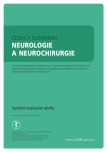Therapy of spinal muscular atrophy
Authors:
J. Haberlová
Authors‘ workplace:
Neuromuskulární centrum Kliniky dětské neurologie, 2. LF UK a FN Motol, Praha
Published in:
Cesk Slov Neurol N 2020; 83/116(Supplementum 2): 21-23
doi:
https://doi.org/10.48095/cccsnn20202S21
Overview
The therapy of spinal muscular atrophy (SMA) with a link to 5q chromosome is nowadays a very hot area. A previously casually not treatable disease, it has been in the US since 2016, and in Europe since 2017. It is newly treatable, and nowadays there are three causal drugs. Two of them, nusinersen (Spinraza) and risdiplam (Ervysdi) increase the synthesis of the SMN protein by modulation of the RNA transcription of the SMN2 gene. These drugs have to be taken regularly, and are lifelong. The third drug, onasemnogene abeparvovec (Zolgensma) is able to substitute the missing SMN1 gene by a syntetic SMN1 gene delivered by viral vector AAV9. It is the first systemic gene therapy in medicine. Until now, this drug was taken only once. There are 4.5 years of data proving its sustaining effect. The first causal therapy was the drug Nusinersen. It has the huge advantage of 10 years’ experience with a high number of treated patients, more than 10,000. This drug does not go through the cerebro-spinal barrier, due to it having to be applied intrathecaly. Nusinersen is in CZ reimbursed for all types and ages of SMA patients. Recently, in August 2020, the drug risdiplam was registered in the US. Its advantage is per oral application; its disadvantage is the short experiences and limited acces in CZ. Risdiplam is not yet registered in the EU, due to this it is available only through the early access program for SMA patients type 1 and 2. The third causal therapy, and second registered drug in the EU, is onasemnogene abeparvovec. Due to the systemic delivery this therapy is limited only for children before the age of 3 years and weighing less than 13.5 kg. Besides, the already registered therapies there are many clinical trials with experimental drugs ongoing – many neuroprotective drugs and muscle strength-enhancing compounds. The actual therapy cannot help with all the symptoms of the disease, it can only mildly improve the motor function and primarily slow down the progression. Due to this, there is still a need for multidisciplinary symptomatic care that should be provided in Neuromuscular Centres.
Keywords:
RNA modulation – gene therapy – symptomatic care – neuromuscular centre
Sources
1. Lefebvre S, Burglen L, Reboullet S et al. Identification and characterisation of a SMA – determining gene. Cell 1995; 80(1): 155–165. doi: 10.1016/ 0092-8674(95)90460-3.
2. Kolb SJ, Kissel JT. Spinal muscular atrophy a timely review. Arch Neurol 2011; 68(8): 979–984. doi: 10.1001/ archneurol.2011.74.
3. Mailman MD, Heinz JW, Papp AC et al. Molecular analysis of spinal muscular atrophy and modification of the phenotype by SMN2. Genet Med 2002; 4(1): 20–26. doi: 10.1097/ 00125817-200201000-00004.
4. Stein CA, Castanotto D. FDA-approved oligonucleotide therapies in 2017. Mol Ther 2017; 25(5): 1069–1075. doi: 10.1016/ j.ymthe.2017.03.023.
5. Darras BT, Farrar MA, Mercuri E. An Integrated safety analysis of infants and children with symptomatic spinal muscular atrophy (SMA) treated with nusinersen in seven clinical trials. CNS Drugs 2019; 33(9): 919–932. doi: 10.1007/ s40263-019-00656-w.
6. Osredkar D, Jílková M, Butenko T et al. Children and young adults with spinal muscular atrophy treated with nusinersen. Eur J Paediatr Neurol 2020 [ahead of print].
7. Strenková J, Voháňka S, Haberlová J et al. REaDY –český registr svalových dystrofií. Cesk Slov Neurol N 2014; 77/ 110(2): 230–234.
8. Mahajan R. Onasemnogene Abeparvovec for spinal muscular atrophy: the costlier drug ever. Int JAppl Basic Med Res 2019; 9(3): 127–128. doi: 10.4103/ ijabmr.IJABMR_190_19.
9. Kirschner J, Butoianu N, Goemans N et al. European ad-hoc consensus statement on gene replacement therapy for spinal muscular atrophy. Eur J Paediatr Neurol 2020; 28: 38–43. doi: 10.1016/ j.ejpn.2020.07.001.
10. Poirier A, Weetall M, Heinig K et al. Risdiplam distributes and increases SMN protein in both the central nervous system and peripheral organs. Pharmacol Res Perspect 2018; 6(6): e00447. doi: 10.1002/ prp2.447.
11. Messina S, Sframeli M. New treatments in spinal muscular atrophy: positive results and new challenges. J Clin Med 2020; 9(7): 2222. doi: 10.3390/ jcm9072222.
12. Zanetta Ch, Riboldi G, Nizzardo M et al. Molecular, genetic and stem cell-mediated therapeutic strategies for spinal muscular atrophy. J Cell Mol Med 2014; 18(2): 187–196. doi: 10.1111/ jcmm.12224.
13. Shorrock HK, Gillingwater TH, Groen EJ. Overview of current drugs and molecules in development for spinal muscular atrophy therapy. Drugs 2018; 78(3): 293–305. doi: 10.1007/ s40265-018-0868-8.
14. Wang CH, Finkel RS, Bertini ES et al. Consensus stateman for standard of care in spinal muscular atrophy. J Child Neurol 2007; 22(8): 1027–1049. doi: 10.1177/ 08830 73807305788.
15. Mercuri E, Finkel RS, Muntoni F et al. Diagnosis and management of spinal muscular atrophy: part 1: recommendations for diagnosis, rehabilitation, orthopedic and nutritional care. Neuromuscul Disord 2018; 28(2): 103–115. doi: 10.1016/ j.nmd.2017.11.005.
16. Finkel RS, Mercuri E, Meyer OH et al. Diagnosis and management of spinal muscular atrophy: part 2: pulmonary and acute care; medications, supplements and immunizations; other organ systems; and ethics. Neuromuscul Disord 2018; 28(3): 197–207. doi: 10.1016/ j.nmd.2017.11.004.
16. SMÁci. [online]. Dostupné z URL: https:/ / smaci.cz/ .
17. Kolpingova rodina Smečno. Dům rodin. [online]. Dostupné z URL: http:/ / www.dumrodin.cz/ .
18. Společnost dětské neurologie. [online]. Dostupné z URL: https:/ / www.detskaneurologie.cz/ .
19. Neuromuskulární sekce České neurologické společnosti. [online]. Dostupné z URL: https:/ / www.neuromuskularni-sekce.cz/ .
Labels
Paediatric neurology Neurosurgery NeurologyArticle was published in
Czech and Slovak Neurology and Neurosurgery

2020 Issue Supplementum 2
Most read in this issue
- Clinical manifestations of spinal muscular atrophy in adult patients
- Genetics of spinal muscular atrophy
- Therapy of spinal muscular atrophy
- Rehabilitation in spinal muscular atrophy
